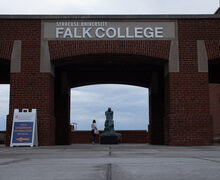‘Oppenheimer’ is the perfect cautionary tale of our time
Arlo Stone | Digital Design Director
In addition to Nolan’s direction, Oppenheimer’s cast helps make the film compelling. Alongside Cillian Murphy’s lead role as J. Robert Oppenheimer, strong supporting performances from Robert Downey Jr., Florence Pugh, Emily Blunt and Matt Damon help bring the history to life.
Get the latest Syracuse news delivered right to your inbox.
Subscribe to our newsletter here.
Technology and its consequences sit center stage in Hollywood at the moment. The Writers Guild of America and the Screen Actors Guild-American Federation of Television and Radio Artists (SAG-AFTRA) are both on strike, demanding film studios place regulations on the use of artificial intelligence in the industry. Fran Drescher, president of SAG-AFTRA, said A.I. is an “existential threat to creative professions.”
Although writer and director Christopher Nolan couldn’t anticipate strikes in his industry regarding the use of A.I., “Oppenheimer” feels like a perfect cautionary tale for our technology obsessed reality. While human beings have invented technologies once thought impossible, Nolan’s 12th feature film reminds audiences they are still responsible for the dire results of those inventions.
The film details the life of theoretical physicist J. Robert Oppenheimer (Cillian Murphy), who, along with Leslie Groves (Matt Damon), directed the creation of the world’s first nuclear weapons, which eventually led to the end of World War II and thus initiated the Cold War. “Oppenheimer” mainly focuses on the man’s early life and the creation of the bomb.
Nolan interweaves the story of a 1959 US Cabinet confirmation hearing for Lewis Strauss (Robert Downey Jr.) alongside Oppenheimer’s 1954 security council hearing. The director cuts between both first-person accounts, citing a storytelling shift for Nolan, who has always written his scripts in the third person.
By grounding the audience in the first person, Nolan gives room for both Murphy and Downey Jr. to deliver their finest performances. Murphy taps into the eccentricity and charm of a man like Oppenheimer. Meanwhile, Downey Jr. has to put on a veneer as a guardian angel for scientists, hiding his vindictive feelings toward Oppenheimer.
We get to see Oppenheimer’s earlier days as an introverted genius studying in Europe, constantly dreaming about the violent movements of matter. This film is completely rooted as a historical drama, but Nolan displays visuals similar to his previous science fiction work like “Interstellar.”
While at UC Berkeley, Oppenheimer flirts with communist ideas, along with Communist Party USA member Jean Tatlock (Florence Pugh). Nolan shows him answering questions about that political past nearly a decade later, highlighting how these seemingly subtle moments became important later in the physicist’s life.
But the true dramatic tension comes from one unlikely probability: if Oppenheimer and his Manhattan Project team detonate an atom bomb, they could set off a chain reaction that ends the world. This climax apexes just over two hours into the film with the Trinity Test.
The Trinity test marked the first time a nuclear weapon was ever detonated. Nolan explicitly tries to capture the thoughts of all the anxious physicists who were uncomfortable with pressing the button. Along with Oppenheimer’s perspective brilliantly portrayed by Murphy, the film relies on remarkable supporting performances from actors like Benny Safdie, Josh Peck and David Krumholtz among others to portray this anxiety of potentially destroying the world.
Once the bomb goes off, the audience witnesses a ball of fire that Nolan and his production crew recreated. Nolan, a man known for his stunts that use little computer-generated effects, outdid himself with this terrifying and awe-inspiring recreation of the explosion. Editor Jennifer Lame, cinematographer Hoyte van Hoytema and special effects supervisor Scott R. Fisher all collaborate to create an image distinctly different from anything shown on screen before.
At the moment of the explosion, Oppenheimer heard the famous words of the Hindu scripture, the Bhagavad Gita, “Now I am become Death, the destroyer of worlds.” Oppenheimer read the scripture earlier in the film while with Tatlock and found new meaning in the words after successfully creating the most deadly weapon in human history.
These words become prophetic for how the rest of the film would turn out. While Oppenheimer celebrated a patriotic victory in performing this miracle, his mind almost immediately moved to dread and doom. The actual implementation of the two bombs on Hiroshima and Nagasaki never gets shown as Oppenheimer can only picture the terror in his head, where we see horrifying visuals and hear remarkably eerie and bombastic sound design. When Oppenheimer is giving a victory speech following Hiroshima and Nagasaki, there are sudden shifts in volume and sound design, adding to the horror the physicist feels in his mind.
After Harry Truman announces the dropping of the two nuclear bombs on Japan, the soldiers at the site of the Manhattan Project celebrate while the scientists all stand still, remaining frozen at the thought of what they had made. This highlights the anxiety we still feel today — that our inventions could eventually destroy us. Nolan takes us into Oppenheimer’s mind as if the bomb ending the world actually happened, but not in the way he once postulated.
“Oppenheimer” shows how people can be the creators of incredible innovations but also the harbingers of their own demise. With brilliant performances from both Murphy and Downey Jr., along with a massive supporting cast, this film will easily be in consideration for one of the finest of the year.
Published on July 24, 2023 at 12:52 am
Contact Henry: [email protected]





